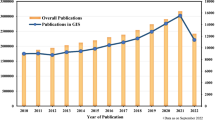Abstract
An approach focused on incorporating semantic content into Geographic Information Systems is proposed. Our methodology is based on a conceptualization of a geospatial domain. The concepts are extracted automatically by analyzing the properties of geospatial objects (in this paper we are primarily focusing on geometrical and topological properties). The concepts are stored in the spatial database to support subsequent processing. The conceptualization of geometric properties is based on measures of geospatial objects. The measurement results obtained by the measurements are classified to obtain representative clusters of values in order to describe these properties. The values are used to define which concept better represents the properties of each object. The conceptualization of topological relations (special case of topological properties) is used to analyze and represent the topology in two levels: intrinsic and extrinsic. The use of semantics is fruitful in problems traditionally treated by numerical approaches.
Preview
Unable to display preview. Download preview PDF.
Similar content being viewed by others
References
Egenhofer, M., Herring, J.: Categorizing topological spatial relationships between point, line and area objects, The 9-intersections: formalism and its use for natural language spatial predicates, Technical report 94-1, National and Analysis, Santa Barbara (1994)
Genesereth, M.R., Nilsson, N.: Logical Foundation of Artificial Intelligence. Morgan Kaufmann, Los Altos, California (1987)
Gruber, T.: Toward principles for the design of ontologies used for knowledge sharing. International Journal of Human-Computer Studies archive 43(5-6), 907–928 (1995); Special issue: the role of formal ontology in the information technology, Year of Publication (1995) ISSN:1071-5819
INEGI, Base de datos geográficos. Diccionario de datos topográficos, Instituto Nacional de Estadística Geografía e Informática (INEGI) (1995)
Mark, D., Egenhofer, M., Hirtle, S., Smith, B.: Ontological Foundations for Geographic Information Science. University Consortium for Geographic Information Science. Emerging Themes in GIScience Research 2000, White Paper (2001), http://www.ucgis.org/emerging/
Molenaar, M.: An Introduction to the Theory of Spatial Object Modelling for GIS. Department of Geo-Informatics, International Institute for Aerospace Survey and Earth Science, Enschede, The Netherlands (1998)
Papadias, D., Theodoris, Y.: Spatial relations, minimum bounding rectangles, and spatial data structures. International Journal of Geographical Information Science 11(2), 111–138 (1997)
Ubeda, T., Egenhofer, M.: Topological Errors Correcting in GIS. In: Scholl, M.O., Voisard, A. (eds.) SSD 1997. LNCS, vol. 1262, pp. 283–297. Springer, Heidelberg (1997)
Author information
Authors and Affiliations
Editor information
Editors and Affiliations
Rights and permissions
Copyright information
© 2006 Springer-Verlag Berlin Heidelberg
About this paper
Cite this paper
Verastegui, K., Martinez, M., Moreno, M., Levachkine, S., Torres, M. (2006). Incorporating Semantics into GIS Applications. In: Gabrys, B., Howlett, R.J., Jain, L.C. (eds) Knowledge-Based Intelligent Information and Engineering Systems. KES 2006. Lecture Notes in Computer Science(), vol 4251. Springer, Berlin, Heidelberg. https://doi.org/10.1007/11892960_84
Download citation
DOI: https://doi.org/10.1007/11892960_84
Publisher Name: Springer, Berlin, Heidelberg
Print ISBN: 978-3-540-46535-5
Online ISBN: 978-3-540-46536-2
eBook Packages: Computer ScienceComputer Science (R0)




